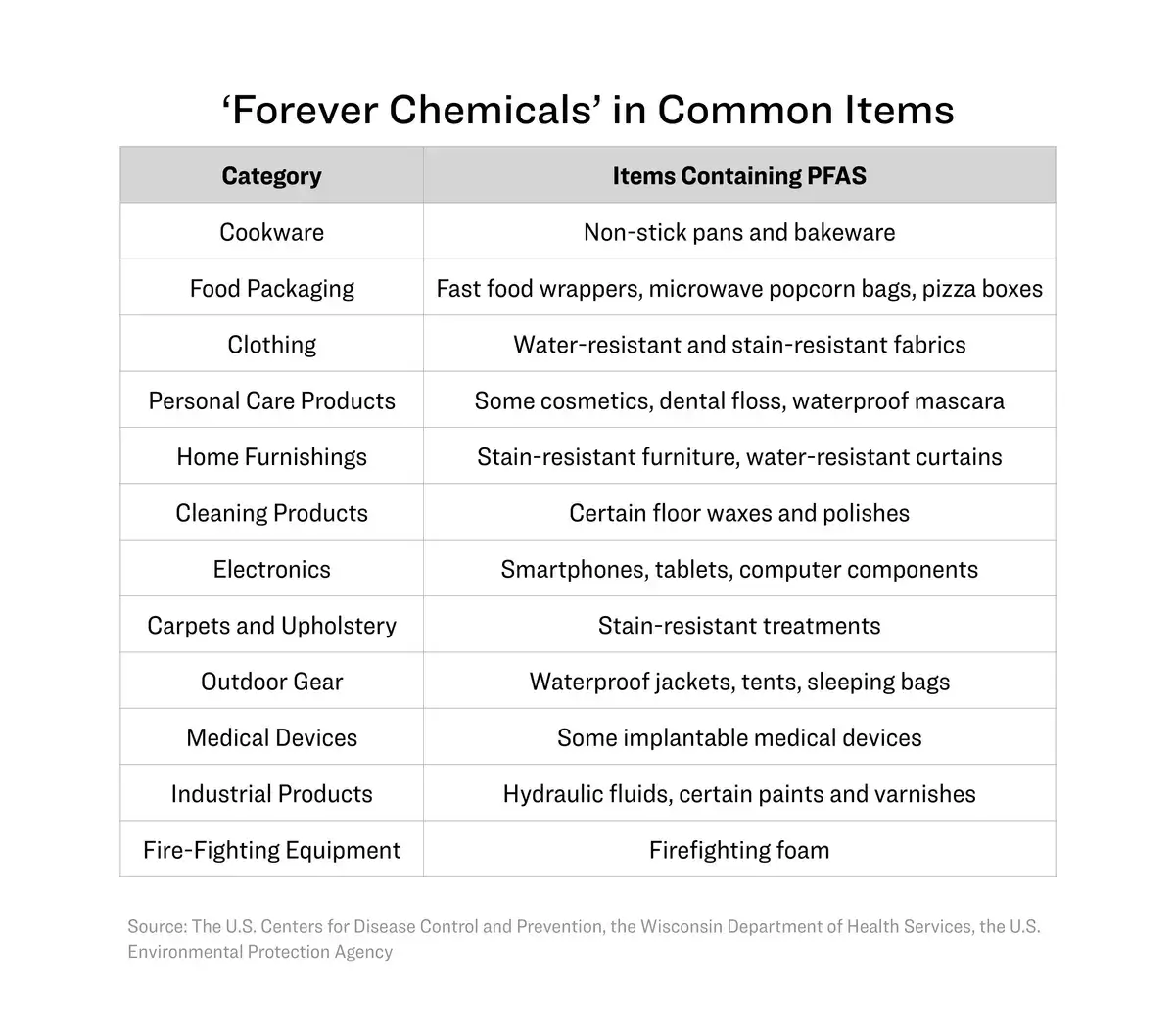
How ‘Forever Chemicals’ Increase Cancer Risk
Learn about risks, research, and reduction strategies.
By: Zena le Roux | The Epoch Times
Invisible invaders lurk in tap water, cling to cookware, and hide in food packaging, posing a silent threat to people’s health. These per- and polyfluoroalkyl substances (PFAS), known as “forever chemicals,” have infiltrated our environment, food, and even our bodies.
As communities across the nation grapple with contamination, scientists are uncovering links between these persistent pollutants and various cancers.
What Are PFAS?
Due to their resistance to breakdown, PFAS have persisted in the environment for centuries. Their widespread use has led to their ubiquitous presence in water supplies, food, and soil. These chemicals accumulate in the body and environment over time.

There has been an alarming increase in PFAS contamination across the United States, David Andrews, a deputy director of investigations and senior scientist at the Environmental Working Group (EWG), told The Epoch Times. As of May 2024, over 6,000 locations in all 50 states were confirmed to be contaminated with these toxic compounds. In comparison, the number of known contaminated sites was 3,186 in an EWG report from August 2023.
New Insights about PFAS & Cancer Development
In March 2024, at a virtual symposium, EWG scientists and university researchers discussed PFAS and cancer links. Alexis Temkin, who holds a doctorate in marine biomedicine and environmental sciences and is a senior toxicologist at the agency, presented on how PFAS promote cancer development, highlighting increased risks of testicular, kidney, and breast cancers from both long-chain and short-chain PFAS in drinking water.
PFAS in drinking water likely explains why the U.S. Centres for Disease Control and Prevention (CDC) has detected these chemicals in at least 97% of Americans’ blood, Mr. Andrews noted.
While PFAS exposure has been linked to various cancers, more research is needed to understand their full impact.
Communities near industrial sites or military bases using PFAS-containing firefighting foams show higher cancer rates. A 2023 study published in Environmental Health Perspectives linked PFOS, chemicals related to PFAS, usually used in nonstick and stain-resistant products, in military personnel’s blood to testicular cancer.
A 2020 review in the International Journal of Environmental Research and Public Health suggested that PFAS exhibit key characteristics of carcinogens, including inducing oxidative stress, suppressing the immune system, and interacting with cell signalling receptors.
Research published in the Journal of the National Cancer Institute in 2024 suggests a link between certain PFAS chemicals and the most common type of childhood cancer globally. The study found connections between higher cancer risk and elevated levels of two specific PFAS: perfluorooctanesulfonic acid and one of its precursors.
PFAS bioaccumulate in the body, particularly in the liver, kidney, testes, and blood serum, Sivanesan Dakshanamurthy, a professor in the Department of Oncology at Georgetown University’s School of Medicine, told The Epoch Times. They interact with cellular receptors and signalling pathways, potentially initiating tumour growth, he said.
PFAS also damage DNA and cellular components and disrupt the immune system’s ability to eliminate cancer cells, Mr. Dakshanamurthy added.
Baba Vanga’s Prediction For 2025 Is Terrifying!
How to Reduce Exposure
Granular activated carbon filters can effectively reduce PFAS levels in drinking water, according to Tasha Stoiber, a senior scientist at EWG with a doctorate in environmental chemistry.
However, reverse osmosis systems, a cleaning method that pushes water through a special filter to remove contaminants, are the most effective at removing PFAS and other contaminants, she noted. These systems can be installed under the sink or as part of a whole-house system.
People can further reduce PFAS exposure by choosing PFAS-free products, such as certain nonstick cookware, water-repellent clothing, and food packaging, Ms. Stoiber added.
Cleaning up PFAS in drinking water requires a multifaceted approach, she said. This involves advanced treatment technologies, public awareness, stopping contamination at the source, and cleaning up contaminated sites.
Comprehensive legislation addressing PFAS production, use, and disposal to prevent further contamination is needed, according to Ms. Stoiber, adding that companies should be held responsible for PFAS pollution and accountable for cleanup costs and preventive measures.
PFAS Policies & Public Health Initiatives
A 2020 study published in Environmental Science & Technology Letters suggests that over 200 million Americans may have PFAS in their drinking water at 1 nanogram per litre—1,000,000 parts per trillion (ppt)—or higher.
This level is concerning, as studies have indicated that even extremely low levels of PFAS can be harmful, Mr. Dakshanamurthy said. The U.S. Environmental Protection Agency (EPA) has set a non-enforceable health advisory level for PFOA and PFOS at 70 ppt.
However, some states have adopted much stricter standards, with safe levels being considered as low as 1 ppt by some studies. For example, Vermont has set a legal limit of 20 ppt for both PFOA and PFOS in groundwater, and Michigan adopted the suggested limit of 70 ppt for these chemicals in groundwater used for tap water.
Mr. Andrews said decades of unregulated PFAS use are a regulatory failure that needs urgent action to reduce health risks and improve regulation, noting that water filters offer a short-term solution.
In February 2024, Sen. Nancy Skinner (D-Calif.) introduced SB 903, the Ending Forever Chemicals Act, aiming to ban PFAS in products by 2030 unless necessary and without safer alternatives. PFAS are already banned in some products—PFOA and PFOS have been phased out from commercial products—but remain in many others, including cleaning and personal care products.
Addressing PFAS contamination requires continuous research, regulation, and technology development due to the chemicals’ stability, persistence, and widespread use, according to Mr. Dakshanamurthy, who noted several efforts to mitigate PFAS risks. These include:
- Government regulations limiting production and use
- Establishing safe exposure guidelines
- Implementing drinking water monitoring and treatment
- Ongoing research on health impacts
- Raising public awareness
Please drop a comment below and let us know your thoughts.
* * *
NEXT UP!
This Artificial Sweetener May Harm The Gut: Study
More people are turning to artificial sweeteners in lieu of sugar in an attempt to reduce their sugar intake to manage their weight and conditions like Type 2 diabetes. However, sugar alternatives can come with their own downsides, and some may cause more problems than they solve.
Neotame, a newer type of artificial sweetener used in things like soft drinks, cakes, and chewing gum can damage the intestine and cause health issues like irritable bowel syndrome (IBS) and sepsis, according to a new in vitro study published in the Frontiers in Nutrition.
What Is Neotame?
* * *
READ MORE: B Vitamins: Your Brain’s Natural Repair Kit
Awareness! How Sugar Changes Your Brain
Telegram: Stay connected and get the latest updates by following us on Telegram!
We’d love to hear from you! If you have a comment about this article or if you have a tip for a future Collective Spark Story please let us know below in the comment section.
